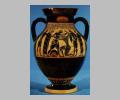[Image not available]
Three-dimensional approximation of the vase

Side A: Theseus and the Minotaur
| Collection: | London, British Museum |
| Summary: | Side A: Dionysiac throng. Side B: Theseus and the Minotaur. |
| Ware: | Attic Black Figure |
| Painter: | Attributed to Lydos |
| Potter: | possibly by (Bloesch) Amasis |
| Date: | 560 BC - 540 BC |
| Dimensions: | H 0.402m |
| Primary Citation: | |
| Shape: | Psykter-amphora |
| Beazley Number: | 310175 |
| Period: | Archaic |
Condition:
There are chips from the rim and the vase is much faded.
Decoration Description:
Side A: The composition is made up of Dionysos, a Maenad, four satyrs and a hare. On the left two hirsute satyrs dance around a maenad. She stands facing right with her long hair tied back. She wears a nebris or fawn skin over her long bordered chiton. Underneath the spout a hairless satyr crouches, facing left and bending over to pet a hare which faces left. Further to the right the god Dionysos stands formally with his drinking horn in his left hand. He wears a long bordered chiton, ornamented with rosettes dotted in added red, and a himation draped over his shoulders. His hair is long and wreathed in ivy. Further right another hirsute satyr raises his left arm, and prances off to the right. All of the satyrs have long, thick hair and beards as well as horses' tails. In addition, three have hairy bodies shown by a stippled pattern. This Dionysiac iconography was a popular choice in the painter's repertoire.
Side B: The central scene shows Theseus killing the Minotaur. A long-haired Theseus on the left strides right. He holds the Minotaur's left arm in his left hand and plunges his sword into the monster's neck with his right. He wears a fillet, cuirass, and short chiton on which there is a large dot rosette in added red on his hip. Beneath his legs is a conical stone on which he has laid his chlamys. The Minotaur, right of center, has a bull's head and mane and the hirsute (stippled) body of a man. He has fallen on his left knee, grabbing Theseus from behind with his right hand and clutching a stone in his left. On each side of the central group are two beardless male figures. Can these youths represent Athenian victims? The one on the right and the one behind Theseus wear striped bordered himatia. The one on the left is nude. The one behind the Minotaur has an embroidered chlamys over his shoulders and his hair tied back. Can these different garments be marks of status? All of the youths have a lock of hair in front twisted over a fillet.
There is a lotus-palmette frieze above the main design. Around the spout are rays. On the flattened lip of the spout there are zigzags. Beneath each handle is a palmette. On the lower body there are two levels of rays. A reserved band runs around the foot.
Shape Description:
This is a vase within a vase with outer part resembling an amphora, accessible through the spout only, and the inner part, accessible through the top. It was used for cooling wine. The cold water was poured into the outer chamber through the spout and the wine was poured into the inner chamber. The Dionysiac iconography on Side A emphasizes the vase's function.
Collection History:
ex Basseggio Collection, 1848
Sources Used: